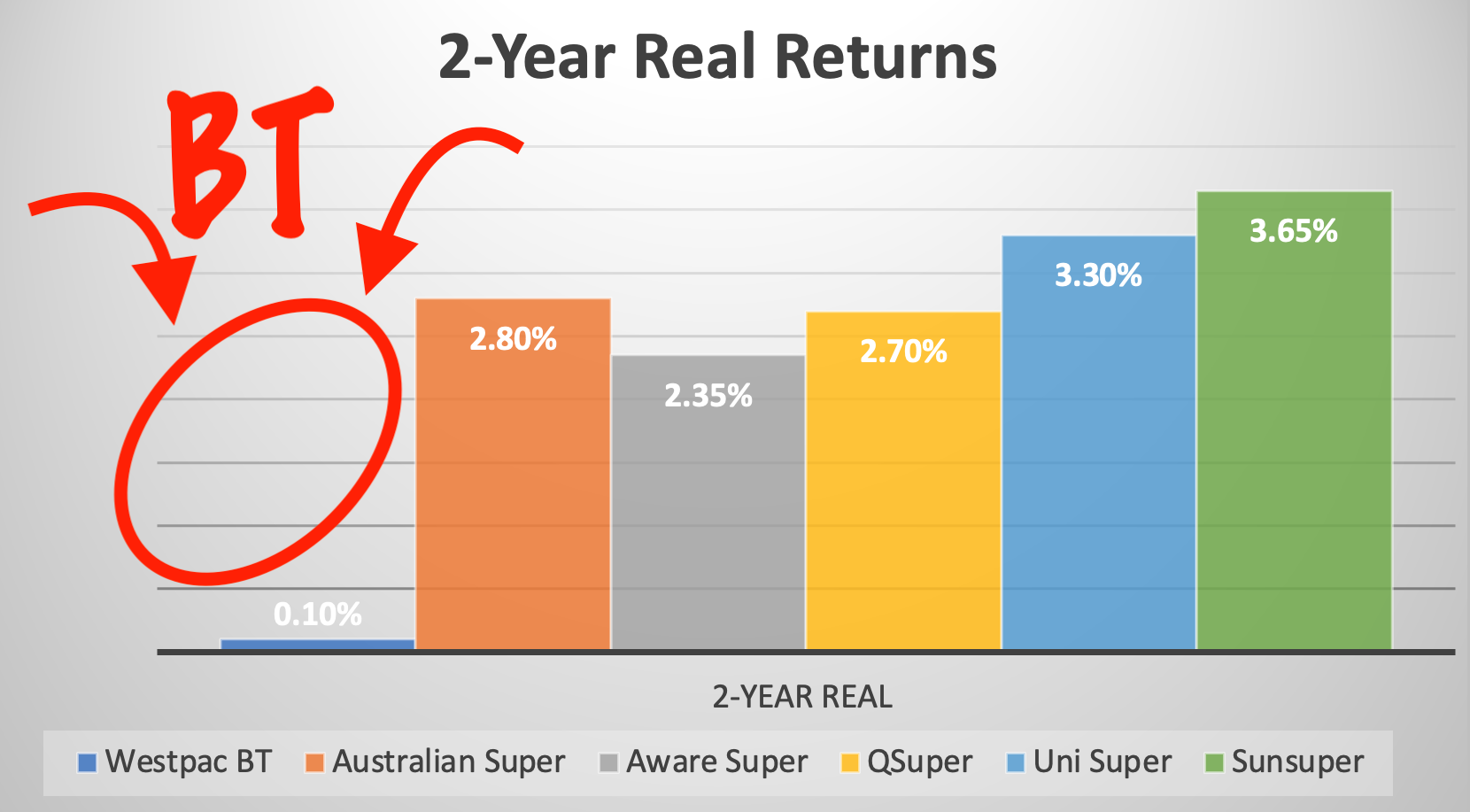A massive $5 billion has been gouged from the life savings of almost 1 million Australians since editor of The Australian newspaper, John Lehmann, inexplicably spiked a major story detailing the scandal. Westpac-BT – which is currently trying to “sell” its multi-billion dollar super gouging machine – says it’s all on Lehmann. Anthony Klan reports.
Appreciate our quality journalism? Please donate here
EXCLUSIVE
Westpac has denied “colluding” with a top editor of The Australian newspaper to have a major expose spiked, with the bank instead claiming the publisher “saw fit not to publish the story”.
Westpac Group has made the claims in a submission to the senate inquiry into Australian media diversity.
They come as The Klaxon can exclusively reveal that since mid-2018, when Westpac was successful in its bid to have the story killed, the bank has fleeced around $5 billion more from the superannuation accounts of almost one million Australians.
The result has been devastating for over 900,000 workers and retirees, with their super growing at just 1/30th of actual market rates.
In mid-2018 then editor (now managing editor) of The Australian newspaper John Lehmann spiked a major expose by this reporter which forensically detailed serious and systemic wrongdoing by Westpac and its superannuation arm, BT.
The expose, which was instead ultimately published by The Klaxon in November last year, revealed that Westpac-BT had gouged over $8 billion from the life savings of almost one million Australians in the decade to 2018.
The investigation revealed Westpac is operating a complex web of obscure paper companies, many of which generate huge fees despite many performing no real service and having zero employees.
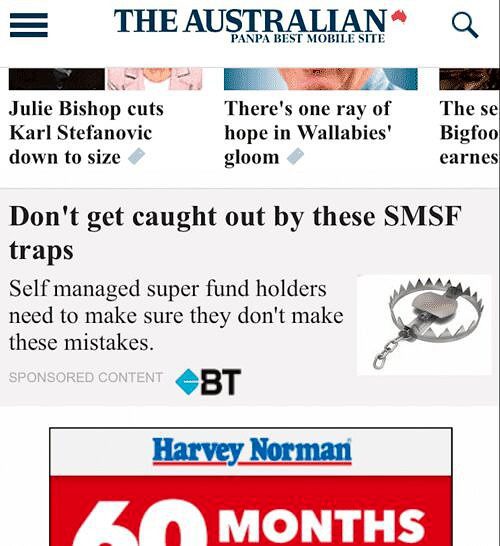
“Sponsored content” – one example of the cash lavished on The Australian by Westpac-BT in 2018. Source: The Australian
Westpac, nor anyone else, has identified a single error in the article – either before or after its publication.
The article was cleared for publication by lawyers at The Australian, with no concerns raised.
In a formal submission to the Media Diversity in Australia media inquiry, Westpac Group head of government and industry affairs, Michael Choueifate, has said the bank “rejects” it colluded with Lehmann to have the expose killed.
“Mr Klan’s submission suggests that Westpac colluded with the publisher of his paper (The Australian) to prevent a story he had submitted from being published,” Choueifate writes.
“We reject these claims and note that Westpac was provided with an opportunity to respond to claims contained in the article by Mr Klan prior to its publication and after receiving our response, the publisher saw fit not to print the story.”
In fact, Westpac had dealt repeatedly over several weeks with this reporter in providing responses to questions.
The bank was given many “opportunities to respond to claims contained in the article” – and it did so.
And Westpac-BT’s responses were included in the article.
It was only immediately prior to publication – after Westpac’s defences were shown to be incorrect – that the bank further ramped-up its – successful – campaign to have the article killed. (More below).
At the time, Westpac-BT was providing substantial sums of money to The Australian.

The story, deeply relevant to more than 900,000 Australian workers and retirees, ultimately ran in The Klaxon in November last year..
When Lehmann spiked and consistently refused to run the story, The Australian was in an ongoing “sponsorship” deal with BT.
During 2018 and 2019 The Australian ran extensive and highly prominent “sponsored content” articles that were written by Westpac-BT and which spruiked the benefits of BT “Wealth” and BT Super.
This is despite Westpac-BT “products”, including superannuation, being consistently among the worst performers in the nation.
They are among the worst performing in the nation because they are extensively gouged by Westpac and BT.

John Lehmann – then editor, now managing editor, The Australian. Source: Supplied.
Financial devastation
Since the expose was killed by Lehmann in mid-2018 the extensive gouging by Westpac-BT has continued unabated.
The Australian Prudential Regulation Authority (APRA) publishes performance data for superannuation funds each financial year.
Westpac-BT’s main superannuation fund is called “Retirement Wrap”.
If you have your superannuation with Westpac-BT (regardless of the specific name of your super “fund”) you are almost certainly in the Retirement Wrap fund.
At June 30 last year (the latest figures) Westpac-BT’s Retirement Wrap fund, a so-called “retail” fund, had 915,722 member accounts totalling $70.83 billion.
To determine the extent of the gouging, we have compared its performance against the performance of the five biggest so-called “industry” funds.
The key difference between industry funds and retail funds is that industry funds do not take members’ superannuation as profit for themselves, whereas the retail funds do.
The five biggest industry funds are: AustralianSuper ($191.4bn and 2.37m members); Aware Super ($126.4bn and 1.08m members); QSuper $120.3bn and 594,000 members; Sunsuper ($68.2bn and 1.52m members) and UniSuper ($85.5bn and 495,600 members).
The hole blown in the life savings of almost 1 million Australians since Lehmann spiked the story in mid-2018 is shown below.
The figures are from APRA’s database for the 2018-19 and 2019-20 financial years and are adjusted to take into account the eroding impact of inflation, with that data from the Reserve Bank of Australia.
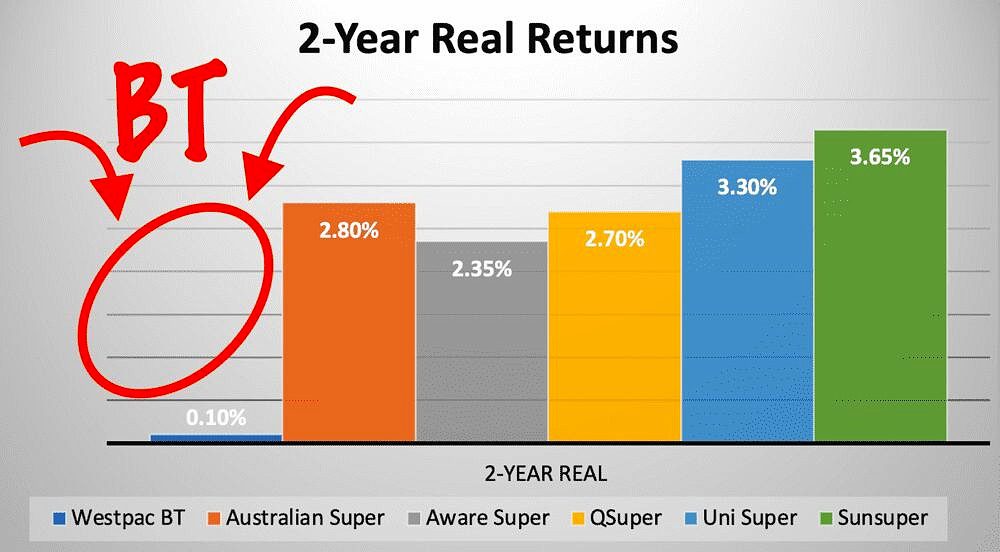
Missing: $3.29 billon gone in just two years as Westpac-BT super returns almost non-existent. Source: APRA, RBA. Graphic: The Klaxon.
The red circle is where the missing $3.29 billion should be.
In the 2018-19 and 2019-20 financial years the average return for the Westpac-BT Retirement Wrap was 0.1%.
For the five biggest “industry” funds, the average return was 2.96%.
That’s 30 times more.
Put another way, if you were one of the almost 1 million Westpac-BT super members and your super instead – hadn’t – been gouged by Westpac-BT, then you would have earned returns 30 times higher than what you actually did.
And that’s just for the 2018-19 and 2019-20 financial years, when loses were $1.53bn and $1.75bn respectively.
This financial year, which ends next week, the loses will be of a similar amount to each of those prior years, taking total losses to $5 billion.
Yet the ultimate losses to Westpac-BT super members are – literally – exponentially higher.
That’s because the billions that have been gouged were instead supposed to be locked away for many years until retirement – earning compound interest in the interim.
Instead it’s earning those members nothing because the money’s no longer theirs.
The $5bn already lost since mid-2018 equates to an average of $5,500 wiped from the life savings of each of Westpac-BT’s almost 1 million members.
The impact is particularly painful given that the average super balance of those members is just $77,000 – in large part because of aggressive gouging by Westpac-BT.

Major “industry” funds deliver average returns 30 times higher than Westpac-BT super. Source: APRA
$13 billion and counting
The $5,500 per head, or $5 billion, is just what’s missing over the past three years.
The gouging by Westpac-BT is comprehensive and long-standing.
In the decade to 2018 a further $8bn-plus was gouged, as the spiked article reveals:
“That means the almost 1m Westpac super members, all forced to put between 9 per cent and 9.5 per cent of every pay packet into super over the past decade under the nation’s compulsory super system, have earned almost nothing on those investments.
In other words, those Westpac super members are, literally, little better off than if they had put their money under their mattresses over the past decade-plus, despite the substantial gains in actual markets over that time. And many are even worse off.
At the same time, the “manager” of those funds for most of the decade – Westpac arm BT Investment Management – gouged on fees.
The value of BT Investment Management, by its own admission, grew astronomically.
Bloated on the fees it was gouging from the 950,000 Westpac super accounts, BT Investment Management grew almost ten times faster than the nation’s top 200 listed companies between 2007 and 2017.
Its shareholders – the biggest being Westpac – were delivered a return of over 600 per cent in that time.
In other words, while the 950,000 people whose super was with Westpac’s BT earned almost zero on their money, BT Investment Management and its owners (Westpac) earned returns of over 600 per cent for “managing” that super.
The “managing” overwhelmingly meant stripping money from those 950,000 super funds.
Over just the five years to June 30 2017, BT Investment Manager Emilio Gonzalez earned $27m.”
“Over the past five years, BTIM has produced a total shareholder return of 622 per cent…which is testament to the successful execution of our strategy” — BT Investment Management
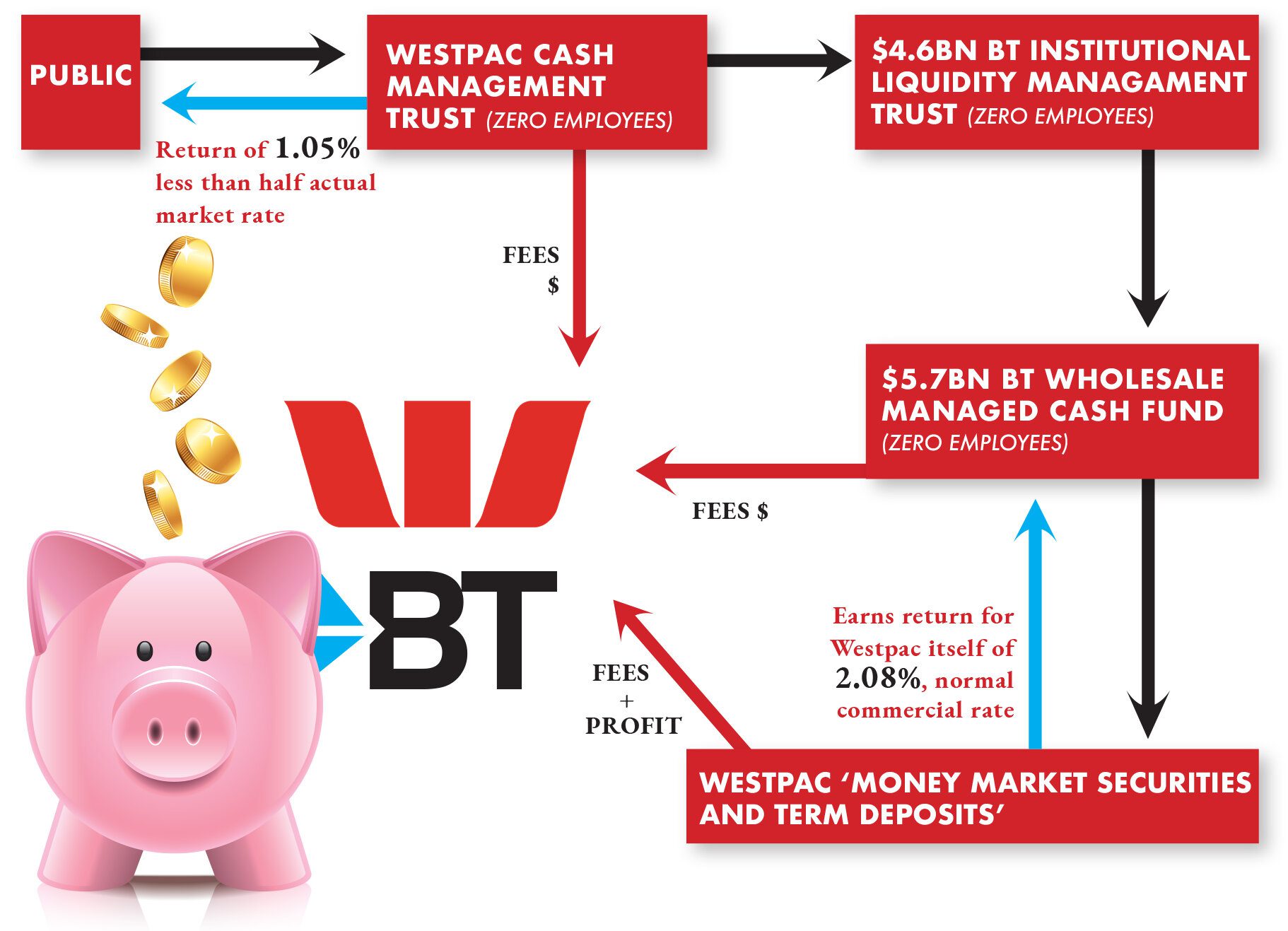
How Westpac and BT gouges billions from super of workers and retirees. It operates a similar model across almost all investment “options”. Source: The Klaxon, Westpac and BT accounts
Choueifate
From Westpac – including Group Head of Government and Industry Affairs Michael Choueifate – it’s more of the same.
(Michael “Mick” Choueifate was formerly chief-of-staff to federal opposition leader Anthony Albanese).
Choueifate’s submission to the media diversity inquiry was in response to a 15-page submission from this reporter, which outlines in great detail the circumstances around the successful campaign by Westpac-BT to kill the expose in mid-2018 (it is submission 243 here).
In his submission, Choueifate writes: “There has been extensive coverage across all forms of media in recent years in relation to the performance of superannuation funds, including the Westpac owned BT”.
“Where claims are made about the performance of BT, Westpac will always seek to ensure that any reporting accurately reflects the facts.”
In this case, Westpac’s efforts involved having the story killed.
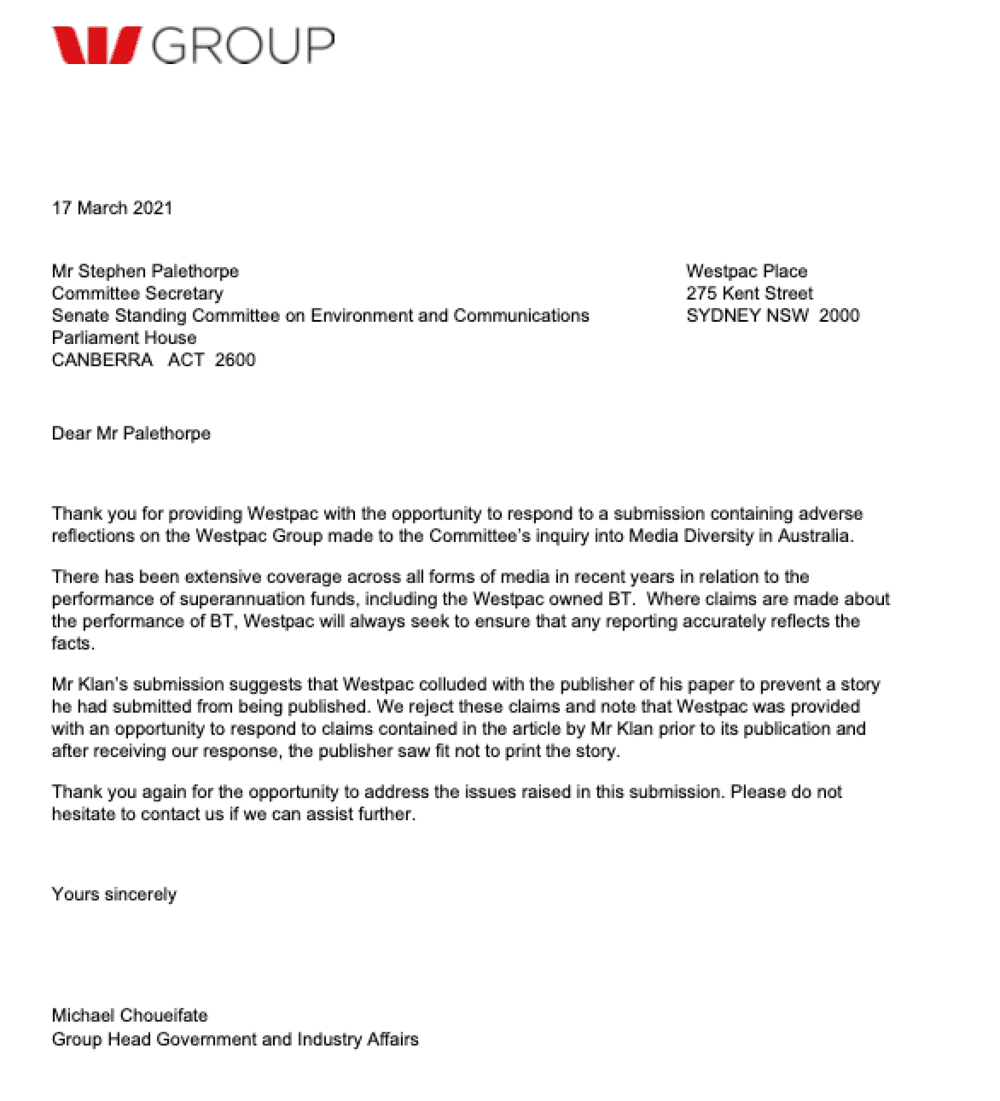
Westpac’s submission to the current media diversity senate inquiry. Source: Westpac
After this reporter exchanged questions and answers with Westpac-BT several times, and it became apparent all excuses for Westpac’s activities and dire performance lacked substance, Westpac-BT simply repeatedly stated: “We do not accept the premise of your questions”.
Westpac steadfastly refused to comment further.
Yet at the same time, two days before the piece was scheduled to run in a major page-one expose in mid-2018, Westpac and senior figures at The Australian co-ordinated behind-the-scenes.
Without the knowledge of this reporter, a teleconference about the article was organised.
The call was conducted on speakerphone in Lehmann’s office.
Present were Lehmann, The Australian’s business editor Eric Johnson, The Australian’s then Sydney bureau chief, Sid Maher (who has since been promoted), and this reporter (who later resigned).
On the other end of the phone were around a dozen Westpac-BT executives.
Lehmann prevented this reporter from speaking during the call, during which Westpac executives made a string of demonstrably false claims.
After the call Lehmann suggested he didn’t “understand” the article.
(Neither Johnston or Maher spoke a word during the call or after.)
Neither Lehmann, or any other executive at The Australian, provided a response as to why the article would not run; and, despite strong protestations by this reporter over many months, none ever have.
The article is not difficult to comprehend and is based on hard evidence from publicly available – and legally audited – sources.
Central to Westpac-BT’s incorrect statements – to which this reporter was prevented from responding – was a claim that comparing Westpac-BT’s overall performance, as per APRA’s audited data, was somehow not comparing like-for-like, or “apples-with-apples”.
Yet this is self-evidently incorrect – the best way of comparing the performance of the Westpac-BT Retail Wrap (and any other super fund) is by viewing the average returns it’s delivered to members.
Some Westpac-BT members will have earned higher returns than the average, but just as many will have earned less – such is the nature of averages.
The story never ran in The Australian, despite repeated pushes by this reporter over many months.
Days after the teleconference Lehmann was due to make a public appearance with Westpac-BT as part of its spruiking of the Westpac-BT super “product”.
The suppression of the story occurred under Westpac’s then CEO Brian Hartzer and chair Lindsay Maxsted.
Hartzer and Maxsted were ousted from the bank after it emerged, in November 2019, that Westpac had engaged in widespread fraudulent activities and facilitated pedophilia.
Westpac is currently seeking to “sell” its BT superannuation business, with reports it is “worth” up to $1 billion.
This process represents Westpac simply selling, to another party, the ability to gouge Westpac-BT’s almost 1 million super members.
If it’s successful, the gouge will continue, just under new ownership.
More to come.
Help us get the truth out from as little as $10/month.
Unleash the excitement of playing your favorite casino games from the comfort of your own home or on the go. With real money online casinos in South Africa, the possibilities are endless. Whether you’re into classic slots, progressive jackpots, or live dealer games, you’ll find it all at your fingertips. Join the millions of players enjoying the thrill of real money gambling and see if today is your lucky day!
The need for fearless, independent media has never been greater. Journalism is on its knees – and the media landscape is riddled with vested interests. Please consider subscribing for as little as $10 a month to help us keep holding the powerful to account.


